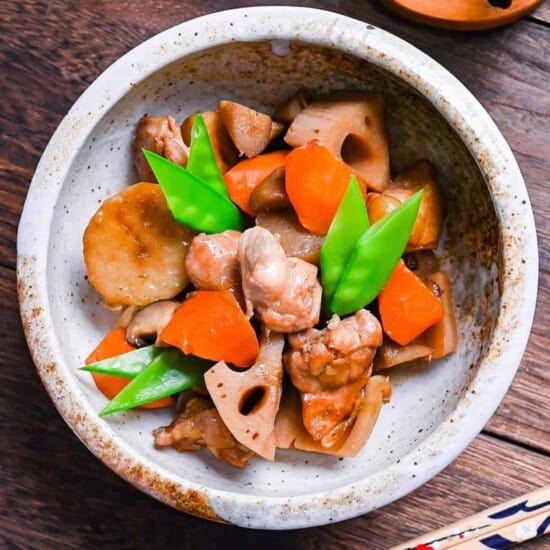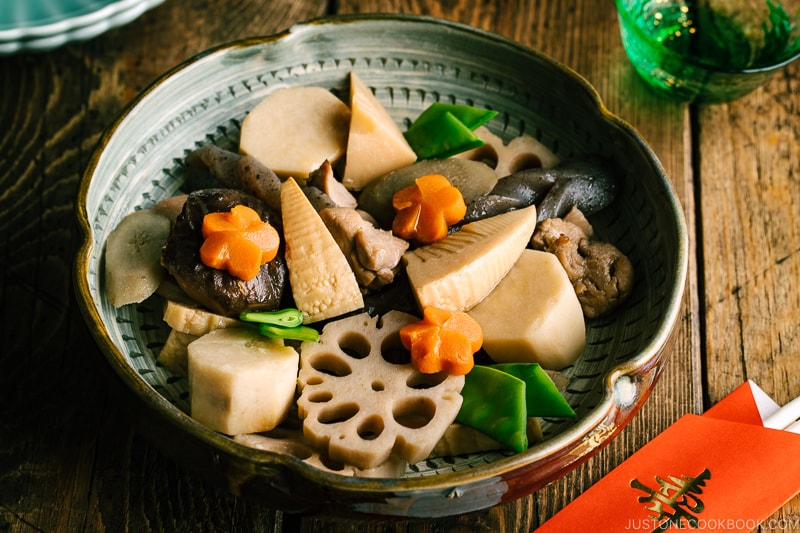Nishime Recipe is a classic Japanese dish made of root vegetables and chicken simmered in dashi, soy sauce, and mirin. It is often served on New Year’s Day and symbolizes the safety of one’s family.
Nishime is a one-pot vegetable stew that is both comforting and delicious, making it a popular choice for special occasions. This traditional Japanese dish can be enjoyed by both vegetarians and meat lovers alike. With its flavorful broth and variety of vegetables, Nishime is a dish that encapsulates the essence of Japanese cuisine.
Whether you’re looking to celebrate a special occasion or simply want to try something new, Nishime is a recipe worth trying.

What Is Nishime?
Nishime is a classic Japanese dish made of root vegetables and chicken simmered in dashi, soy sauce, and mirin. It is often served on New Year’s Day and symbolizes the safety of one’s family. Try this comforting and flavorful one-pot stew for special occasions.
Nishime, also known as Chikuzenni, is a classic Japanese dish that is traditionally served on New Year’s Day. It is a hearty and flavorful one-pot stew made with a combination of root vegetables and chicken simmered in a delicious broth. This dish is rich in umami and is a symbol of safety and well-being for the family.
Classic Japanese Dish
Nishime, also known as Chikuzenni, is a beloved classic Japanese dish that has been enjoyed for generations. It is a staple on special occasions and is particularly popular during New Year celebrations. The dish showcases the flavors of Japan, combining a variety of root vegetables and chicken in a savory broth.
Ingredients And Preparation
In order to make Nishime, you will need the following ingredients:
| Ingredients | Quantity |
|---|---|
| Root vegetables (e.g., daikon, carrot, burdock root, bamboo shoots) | As needed |
| Chicken (thighs or breast) | As needed |
| Dashi (Japanese soup stock) | As needed |
| Soy sauce | As needed |
| Mirin (Japanese sweet rice wine) | As needed |
To prepare Nishime, follow these simple steps:
- Cut the root vegetables and chicken into bite-sized pieces.
- In a pot, combine the dashi, soy sauce, and mirin to make the flavorful broth.
- Add the root vegetables and chicken to the pot.
- Simmer the ingredients on low heat until they are tender and the flavors have melded together.
- Serve the Nishime hot and enjoy!
Nishime is a versatile dish that can be customized to your taste. Feel free to add or substitute different vegetables and proteins to create your own unique version of this classic Japanese stew.

Difference Between Umani And Nishime
Nishime is a classic Japanese dish made with root vegetables and chicken simmered in dashi, soy sauce, and mirin. Umani, on the other hand, is a Japanese stew with meat and an array of vegetables simmered in a savory and sweet broth.
Though both dishes are delicious, nishime typically contains only vegetables.
Definition Of Umani|
Umani is a Japanese stew that typically includes meat along with an array of Japanese root vegetables. This savory and sweet broth is made by simmering chicken pieces and vegetables in a flavorful broth made with soy sauce and mirin.
Vegetables In Nishime
In Nishime, a classic Japanese dish, root vegetables take center stage. Some common vegetables used in Nishime include:
- Lotus root
- Snow peas
- Burdock root
- Bamboo shoots
- Mushrooms (such as shiitake)
- Taro
These vegetables are simmered in a pot along with chicken or pork, creating a colorful and flavorful one-pot stew.
At our house, we often referred to Umani as nishime, despite the technical difference between the two. While Umani traditionally contains meat, nishime is typically made with only vegetables.
The symbolism behind nishime is also worth noting. This dish is often served during New Year’s celebrations and represents the safety and well-being of one’s family.
If you’re wondering how to prepare the daikon radish for nishime, you can refer to this helpful video on YouTube.
Overall, both Umani and Nishime are delicious and comforting dishes that showcase the flavors of Japanese cuisine. Whether you prefer the meaty umami flavors of Umani or the vibrant assortment of vegetables in Nishime, these dishes are sure to satisfy your taste buds.
Symbolism Of Nishime
Nishime, a classic Japanese dish, is a symbol of family safety and is often served on New Year’s Day. This one-pot vegetable stew combines root vegetables and chicken, simmered in a flavorful broth of dashi, soy sauce, and mirin. Perfect for celebrating special occasions or for a comforting meal at home.
Represents Family Safety
Nishime, a classic Japanese dish often served on New Year’s Day, holds deep symbolism. It represents the safety and well-being of one’s family. This one-pot vegetable stew is a colorful array of root vegetables and either chicken or pork, simmered together in a flavorful broth. The tradition of making Nishime on New Year’s Day ensures a prosperous and secure year ahead for the family.

How To Cut Daikon For Nishime
Daikon radish is an essential ingredient in Nishime, a classic Japanese dish that is often served on New Year’s Day. Daikon radish adds a unique flavor and texture to the dish, but cutting it can be a bit tricky if you’re not familiar with the process. In this section, we will guide you through the steps to cut daikon radish for Nishime, ensuring that you do it effortlessly and efficiently.
Steps To Cut Daikon Radish
1. Preparation
Before you begin cutting the daikon radish for Nishime, make sure you have a sharp knife, a cutting board, and a clean daikon radish.
2. Trim the Ends
Start by trimming both ends of the daikon radish using a sharp knife. This process will ensure that you have a uniform shape to work with and remove any potential dirt or imperfections.
3. Peeling
Using a vegetable peeler or a sharp knife, carefully peel the skin off the daikon radish. It’s essential to remove the outer layer as it can be tough and bitter, affecting the overall taste of the Nishime.
4. Cutting into Rounds
Once the daikon radish is peeled, cut it into rounds of about 1/4 inch thickness. You can adjust the thickness according to your preference, but keep in mind that thinner slices will cook faster, while thicker slices will retain a bit of crunch.
5. Cutting into Strips
If you prefer a different shape for your daikon radish in Nishime, you can cut the rounds into thin strips. This shape variation adds visual interest to the dish and allows for even cooking.
6. Final Check
After cutting the daikon radish for Nishime, give it a final check to ensure that the pieces are of uniform size, as this will ensure they cook evenly. Make any adjustments needed by recutting if necessary.
Now that you know how to cut daikon radish for Nishime, you’re ready to incorporate this essential ingredient into your dish. Remember that the way you cut the daikon radish can affect the texture and overall enjoyment of the Nishime, so take your time and follow these steps for the best results.
Recipes Featuring Nishime
If you’re searching for comforting and delicious recipes, look no further than Nishime. This traditional Japanese dish is a one-pot stew made with root vegetables and tender chicken simmered in a flavorful broth. With its rich flavors and hearty ingredients, Nishime is the perfect comfort food for any occasion. Whether you’re a meat lover or a vegetarian, there’s a Nishime recipe that will satisfy your taste buds. Let’s dive into some mouthwatering recipes that feature Nishime!
Comforting Nishime Recipe
If you’re in need of some warmth and comfort, this Comforting Nishime Recipe is just what you’re looking for. Made with a medley of root vegetables, such as lotus roots, bamboo shoots, and burdock root, this dish offers a delightful combination of textures and flavors. The vegetables are simmered in a savory broth, infused with dashi, soy sauce, and mirin, giving it a rich and delicious taste that will leave you craving for more. This Nishime recipe is the epitome of comfort food that will warm your soul on a chilly day.
Easy Chicken Nishime Recipe
If you’re a chicken lover, this Easy Chicken Nishime Recipe is a must-try. Tender chicken thighs are combined with hearty root vegetables like lotus roots, bamboo shoots, and snow peas, creating a delicious and satisfying dish. The chicken and vegetables are simmered to perfection in a flavorful broth, resulting in a comforting and flavorful meal. This recipe is perfect for those busy days when you want a wholesome and nutritious meal without spending too much time in the kitchen.
Simmered Vegetables (nishime) Recipe
For all the vegetarians out there, this Simmered Vegetables (Nishime) Recipe is a delightful option. Packed with an array of colorful vegetables, such as snow peas, taro, and dried shiitake mushrooms, this Nishime dish is both nutritious and delicious. The vegetables are simmered in a flavorful broth, infused with soy sauce and dashi, resulting in a dish that bursts with flavors. This Simmered Vegetables (Nishime) recipe is a perfect choice for those looking for a healthy and satisfying meal.
Instant Pot Nishime Recipe
If you’re a fan of quick and easy meals, this Instant Pot Nishime Recipe is for you. With the help of an Instant Pot, you can enjoy a delicious and flavorful Nishime dish in no time. Simply toss in your favorite combination of root vegetables, chicken or pork, and the flavorful broth ingredients into the Instant Pot, and let it do its magic.
In just a short amount of time, you’ll have a hearty and delicious Nishime ready to be enjoyed. This Instant Pot Nishime recipe is perfect for busy individuals who want a quick and satisfying meal without compromising on taste.
Frequently Asked Questions On Nishime Recipe
What Is Nishime Made Of?
Nishime is made of root vegetables and chicken simmered in a broth made with dashi, soy sauce, and mirin. It is a classic Japanese dish often served on New Year’s Day.
What Is The Difference Between Umani And Nishime?
Umani is a Japanese stew with meat, while Nishime is a vegetable stew. Umani contains meat and an assortment of root vegetables simmered in a savory and sweet broth. On the other hand, Nishime is made only with vegetables, symbolizing the safety of one’s family.
What Does Nishime Symbolize?
Nishime symbolizes the safety of one’s family. It is a classic Japanese dish made of root vegetables and chicken simmered in dashi, soy sauce, and mirin.
How Do You Cut Daikon For Nishime?
To cut daikon for Nishime, follow these easy steps: 1. Peel the daikon and slice it into thick rounds. 2. Lay the rounds flat and cut them into quarters. 3. Finally, cut each quarter into bite-sized pieces. Enjoy cooking!
Conclusion
To conclude, Nishime is a classic Japanese dish that combines root vegetables and chicken in a savory broth. This one-pot stew is a staple for special occasions and symbolizes the safety and well-being of one’s family. With its comforting flavors and colorful array of ingredients, Nishime is a must-try recipe that will delight both vegetarians and meat lovers alike.
So why not give this delicious and traditional dish a try in your own kitchen? You won’t be disappointed!

